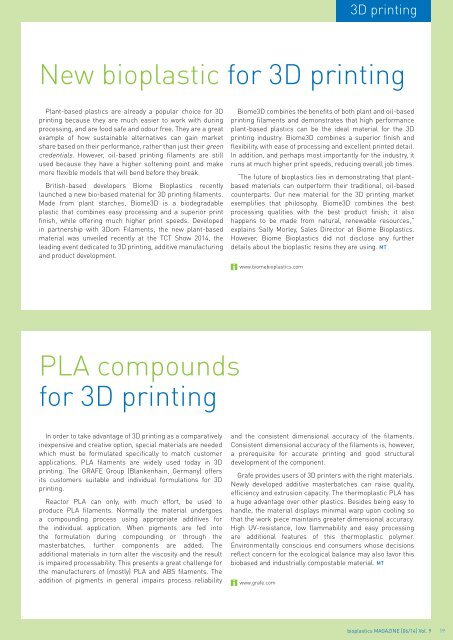bioplasticsMAGAZINE_1406
bioplasticsMAGAZINE_1406
bioplasticsMAGAZINE_1406
Create successful ePaper yourself
Turn your PDF publications into a flip-book with our unique Google optimized e-Paper software.
3D printing<br />
New bioplastic for 3D printing<br />
Plant-based plastics are already a popular choice for 3D<br />
printing because they are much easier to work with during<br />
processing, and are food safe and odour free. They are a great<br />
example of how sustainable alternatives can gain market<br />
share based on their performance, rather than just their green<br />
credentials. However, oil-based printing filaments are still<br />
used because they have a higher softening point and make<br />
more flexible models that will bend before they break.<br />
British-based developers Biome Bioplastics recently<br />
launched a new bio-based material for 3D printing filaments.<br />
Made from plant starches, Biome3D is a biodegradable<br />
plastic that combines easy processing and a superior print<br />
finish, while offering much higher print speeds. Developed<br />
in partnership with 3Dom Filaments, the new plant-based<br />
material was unveiled recently at the TCT Show 2014, the<br />
leading event dedicated to 3D printing, additive manufacturing<br />
and product development.<br />
Biome3D combines the benefits of both plant and oil-based<br />
printing filaments and demonstrates that high performance<br />
plant-based plastics can be the ideal material for the 3D<br />
printing industry. Biome3D combines a superior finish and<br />
flexibility, with ease of processing and excellent printed detail.<br />
In addition, and perhaps most importantly for the industry, it<br />
runs at much higher print speeds, reducing overall job times.<br />
“The future of bioplastics lies in demonstrating that plantbased<br />
materials can outperform their traditional, oil-based<br />
counterparts. Our new material for the 3D printing market<br />
exemplifies that philosophy. Biome3D combines the best<br />
processing qualities with the best product finish; it also<br />
happens to be made from natural, renewable resources,”<br />
explains Sally Morley, Sales Director at Biome Bioplastics.<br />
However, Biome Bioplastics did not disclose any further<br />
details about the bioplastic resins they are using. MT<br />
www.biomebioplastics.com<br />
PLA compounds<br />
for 3D printing<br />
In order to take advantage of 3D printing as a comparatively<br />
inexpensive and creative option, special materials are needed<br />
which must be formulated specifically to match customer<br />
applications. PLA filaments are widely used today in 3D<br />
printing. The GRAFE Group (Blankenhain, Germany) offers<br />
its customers suitable and individual formulations for 3D<br />
printing.<br />
Reactor PLA can only, with much effort, be used to<br />
produce PLA filaments. Normally the material undergoes<br />
a compounding process using appropriate additives for<br />
the individual application. When pigments are fed into<br />
the formulation during compounding or through the<br />
masterbatches, further components are added. The<br />
additional materials in turn alter the viscosity and the result<br />
is impaired processability. This presents a great challenge for<br />
the manufacturers of (mostly) PLA and ABS filaments. The<br />
addition of pigments in general impairs process reliability<br />
and the consistent dimensional accuracy of the filaments.<br />
Consistent dimensional accuracy of the filaments is, however,<br />
a prerequisite for accurate printing and good structural<br />
development of the component.<br />
Grafe provides users of 3D printers with the right materials.<br />
Newly developed additive masterbatches can raise quality,<br />
efficiency and extrusion capacity. The thermoplastic PLA has<br />
a huge advantage over other plastics. Besides being easy to<br />
handle, the material displays minimal warp upon cooling so<br />
that the work piece maintains greater dimensional accuracy.<br />
High UV-resistance, low flammability and easy processing<br />
are additional features of this thermoplastic polymer.<br />
Environmentally conscious end consumers whose decisions<br />
reflect concern for the ecological balance may also favor this<br />
biobased and industrially compostable material. MT<br />
www.grafe.com<br />
bioplastics MAGAZINE [06/14] Vol. 9 19


















